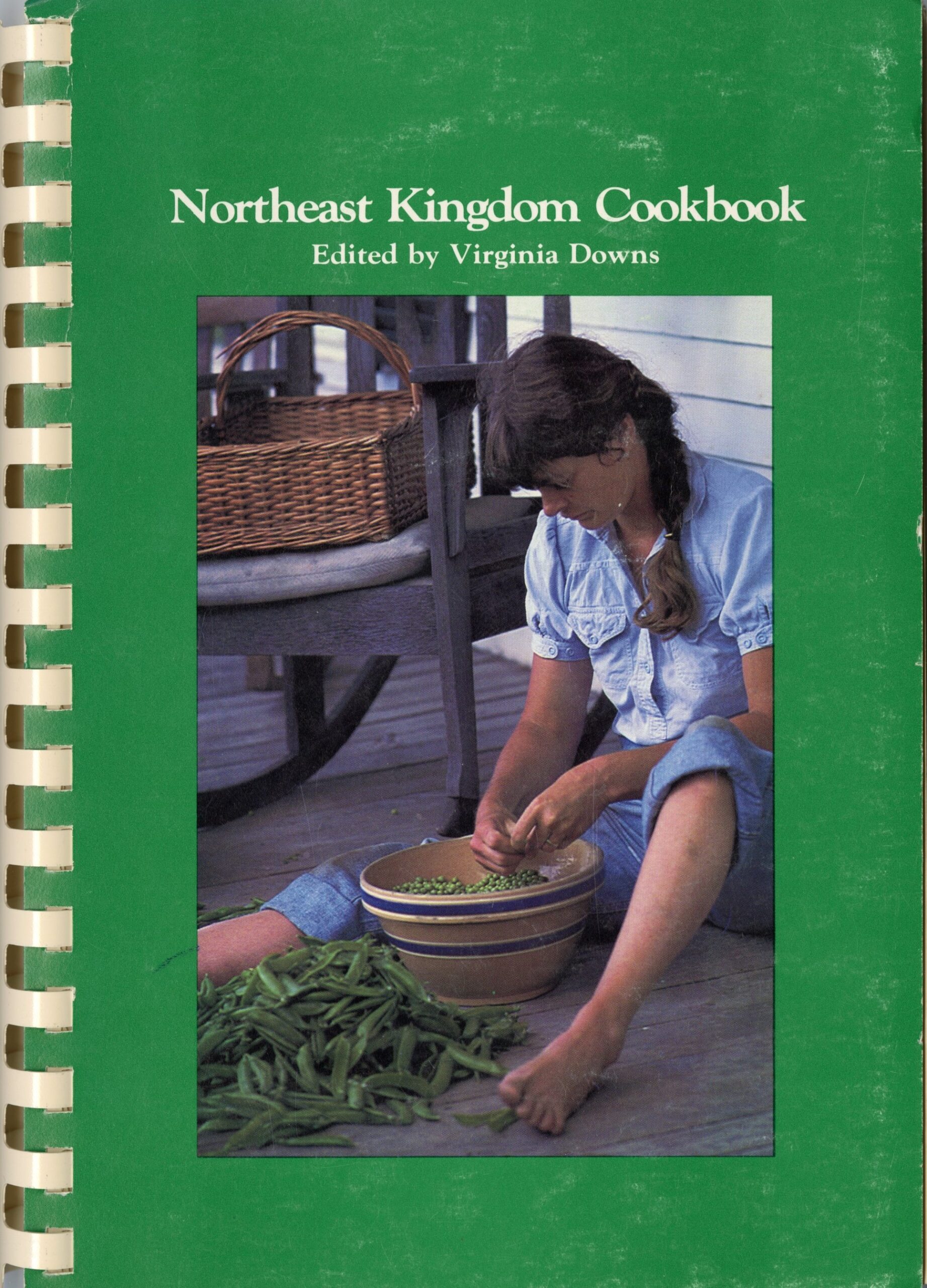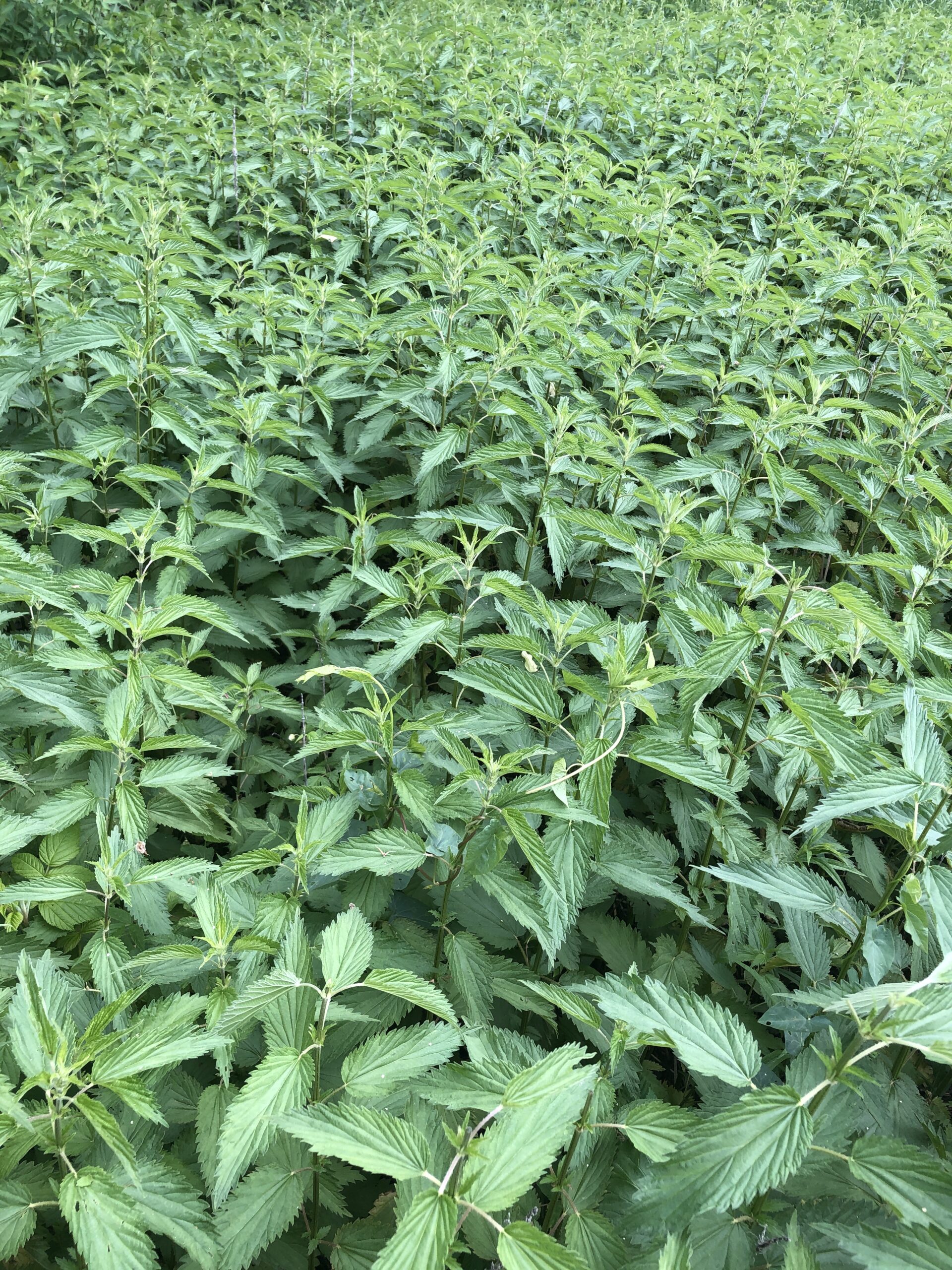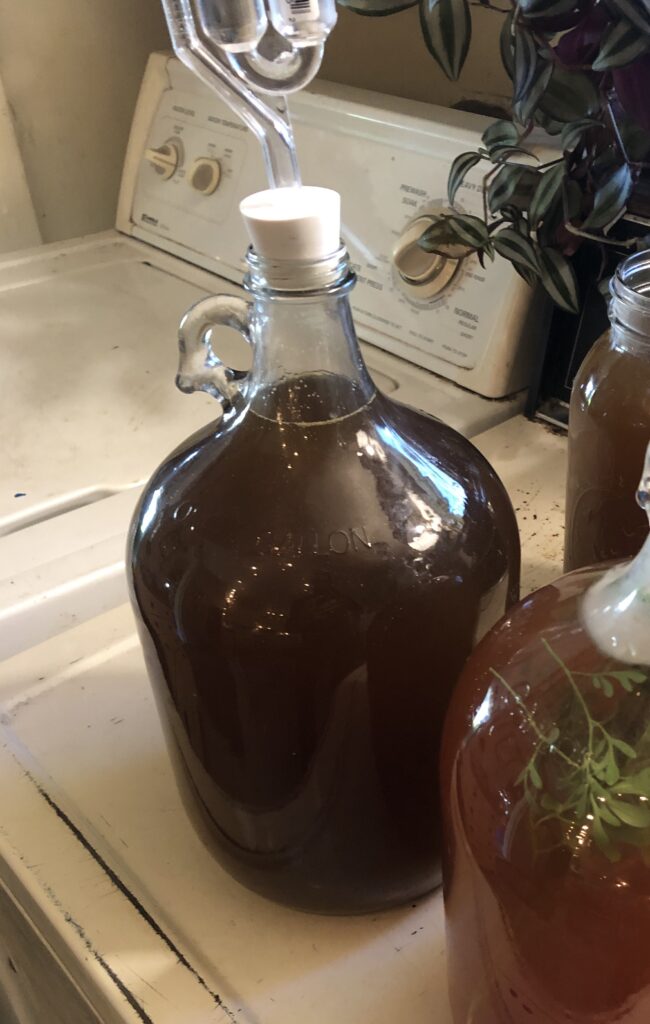The fourth post in our series on cooking with recipes from our Vermont cookbook collection was contributed by Richard Witting, a UVM History graduate student as well as a chef, caterer and avid wildcrafter (forager). He joined Special Collections staff member Ingrid Bower to explore cookbooks, gather wild ingredients, and test recipes.
Foraging for Recipes
On a hot day in mid-June after much anticipation, I walked into the Silver Special Collections Library for the first time. Giddy as a schoolboy, I was led to the cookbook section where, in the silence of the library, I was able to spend the next three hours examining culinary pamphlets and faded spiral bound community cookbooks that came from Vermont authors, small towns and churches, setting aside some, putting most back. Although I wanted to tarry longer on many of them, eager to look for the human stories and unique recipes within, I was after a specific type of recipe—those that used wild or foraged ingredients.
Sitting down at a table with a stack of books that looked to hold the most promise, I scanned the recipes. I had hoped the older cookbooks, from the later 1800s, might show some link to the foodways of early European settlers in Vermont but there was little there to be found. There were some Abenaki cookbooks, but that seemed like a special topic for another post.
Most of the plastic spiral bound community cookbooks from the 1960s hold many of the same recipes, reflecting the progress of national food trends (jello salads, meat balls, casseroles) or generic New England staples like boiled dinner, clam chowder, or American chop suey. Peppered throughout these cookbooks I did occasionally find a recipe using mostly familiar wild foods like fiddleheads, dandelions, and raspberries but also a few rarer ingredients like chokecherries, gooseberries and, surprisingly, a few recipes for pickled nasturtium pods.
 Among these mostly rather droll community cookbooks however there was one book that, from the second I saw the title, I suspected would be more interesting: The Northeast Kingdom Cookbook: Recipes & Remedies from Vermont (1986). If there was anywhere I expected to find a cookbook with a regional character the NEK was likely to be it. Flipping through it, not only did I see numerous and creative recipes using wild edibles, but I also saw stories about the recipes and where they came from. Many were especially unique (Bluefish, Gin and Wine Flambé, Elderflower Blow ), some crass and funny (Thighs of Delight, Slut Biscuits) and some truly enigmatic (Shaggy Manes a la Ambiguity, Mystery Morsels).
Among these mostly rather droll community cookbooks however there was one book that, from the second I saw the title, I suspected would be more interesting: The Northeast Kingdom Cookbook: Recipes & Remedies from Vermont (1986). If there was anywhere I expected to find a cookbook with a regional character the NEK was likely to be it. Flipping through it, not only did I see numerous and creative recipes using wild edibles, but I also saw stories about the recipes and where they came from. Many were especially unique (Bluefish, Gin and Wine Flambé, Elderflower Blow ), some crass and funny (Thighs of Delight, Slut Biscuits) and some truly enigmatic (Shaggy Manes a la Ambiguity, Mystery Morsels).
Besides the rows of community and church cookbooks there were a few others, published roughly from the 1930s to the 1960s, that tried to represent— or invent—a unique regional Vermont culinary identity. A few of these I was familiar with, including the books by the fictional Mrs. Appleyard (Louise Andrews Kent), made popular by her column in Vermont Life magazine, and A Vermont Cook Book by Vermont Cooks, first issued in 1946 with its rustic, folksy, hand-painted wooden cover and reprinted numerous times over the next four decades.
However, there were a few more I had never seen, including one that jumped out to me. The Green Mountain Cook Book by Aristene Pixley (1934) has a lengthy introduction about Vermont character and cooking, as well as an extensive section on home brewed fermented beverages. Setting aside the rest of the stack I decided to hone in on The Northeast Kingdom Cookbook and The Green Mountain Cook Book.
Nettle Beer from Aristene Pixley’s The Green Mountain Cook Book
The Green Mountain Cook Book was published by the Stephen Daye Press in Brattleboro, famous for their New England nostalgia-focused books. Flipping through the book, I felt like it had a story to tell. While not wholly different from cookbooks of its era, interspersed are recipes using Gilfeather turnips—a uniquely Vermont variety—and recipes for bass, perch, pickerel and frogs legs. Most intriguing though, it contains an extensive list of unique beverages, including beef tea, flax seed lemonade, grape shrub, rhubarb wine, metheglin, elderberry beer, Vermont beer made from hops and molasses, spruce beer and nettle beer. Looking through this list, and considering the time of year, I knew that nettles could still be found, and what exactly nettle beer would taste like intrigued me.
 Having done a decent amount of brewing in my life, the recipe raised a few questions for me as I came up with my plan for making it. First, I decided I did not need three gallons, so I decided to halve the recipe. Next, I would need some nettles. Luckily while visiting a friend in Huntington I was easily able to gather a pound of nettle crowns—with some thick gloves and scissors. Vermont has two types of nettles, wood nettle (Laportea canadensis), an indigenous variety that grows prolifically along river banks below the shade of cottonwoods and box elders, and stinging nettle (Urtica dioica), which is an introduced species from Europe. Though both are edible, recipes usually call for the latter so that’s what I gathered.
Having done a decent amount of brewing in my life, the recipe raised a few questions for me as I came up with my plan for making it. First, I decided I did not need three gallons, so I decided to halve the recipe. Next, I would need some nettles. Luckily while visiting a friend in Huntington I was easily able to gather a pound of nettle crowns—with some thick gloves and scissors. Vermont has two types of nettles, wood nettle (Laportea canadensis), an indigenous variety that grows prolifically along river banks below the shade of cottonwoods and box elders, and stinging nettle (Urtica dioica), which is an introduced species from Europe. Though both are edible, recipes usually call for the latter so that’s what I gathered.
I then boiled the nettles in a pot with some water. Looking ahead, the recipe calls for diluting the boiled concentrated nettle water. Not seeing what would be gathered by reducing it and then adding water, I used more water so the nettles stayed submerged during boiling. Having worked with herbs and teas, I didn’t see the point of boiling it for a lengthy time, as most of the essence would come out quickly from a tender plant like nettle,
Next I combined the ingredients as instructed. It was unclear to me if the lemon rind would include the pith as well as the peel. I decided to go with just the peel so as not to make the brew overly bitter.
The cream of tartar in the recipe had me scratching my head wondering what purpose it served. Usually cream of tartar in used in baking, often with eggs to stiffen peaks. I emailed my friend Ricky Klein, who owns Groenfell Meadery, and asked him what he thought it would do in the recipe. He said cream of tartar is used for its semi sweet-sour flavor to add complexity to beverages. The internet also said it helped give a foamier head to drinks like root beer.
After mixing everything and letting it cool, I then had to add in a “yeast cake.” Yeast cakes, as far as I know, are an old-time unit of baker’s yeast. Not wishing to try and track down a yeast cake, and knowing that beverages brewed with baker’s yeast, rather than brewer’s yeast, just aren’t as good, I decided to use a package of champagne yeast I had on hand.
 The recipe also calls for doing this all in a crock, something I don’t have in the correct size for this project. So instead, I used a jug with an airlock.
The recipe also calls for doing this all in a crock, something I don’t have in the correct size for this project. So instead, I used a jug with an airlock. But for authenticity, I made a smaller jar with a loose-fitting lid as well. Within an hour the nettle beer was bubbling along.
While waiting for the nettle beer to brew I couldn’t help but wonder who Aristene Pixley was. The name had a certain seelie-like ring to it that evoked deep green Vermont forests and shadowy mountains filled with ancient wisdom. In other words, it sounded like a pseudonym. Doing some quick googling I couldn’t find any birth or death records for an Aristene Pixley.
I did find a number of contemporaneous articles about the publishing of her cookbook. The Burlington Free Press noted that “Aristene Pixley, a former play-producer …has chosen this as her pen name. She is a Vermonter born and bred” (December 8, 1934). This confirmed that the name was a pseudonym, possibly to cover that the author might not pass muster, having spent some part of their life apparently as a big city flatlander.
The Bennington Evening Banner offered a more scathing review. “The author is Aristene Pixley, a nom de plume perhaps to save her from verbal chastisement from those reckless enough to try her recipes” (August 8, 1934). The writer’s criticism focused on some of the recipes, specifically a recipe for “kumyss,” a Turkic-Mongolian drink, that also had me wondering at how it got there; her directions for making metheglin, a spiced mead that she was apparently not making in a way that either Ira or Ethan Allen had; and lastly her pairing of brook trout with watercress when, according to the author, the season for those two does not coincide. Cowslips, he wrote, might be a more appropriate pairing. I would later discover that the author’s name, penciled in on the Silver Collections copy, was in fact Helen Elizabeth Tyler.
 Two days later, when the recipe said I should bottle it, the nettle beer was still bubbling away at a rate that, if bottled, I knew would be a risk for bottle explosion. Three more days later, the bubbling had slowed to a reasonable rate and I felt I could bottle it. The beer had turned opaque and the green tone faded to a brown. Taking a small cup, I gave it a try. At this point the nettle beer didn’t really have that much to offer—a bit of a taste of ginger and yeast. Considering how many nettles went into this brew though, I imagine it must be filled with nutrients and that, perhaps like spruce beers which were high in vitamin C and prevented scurvy, nettles would serve a similar purpose.
Two days later, when the recipe said I should bottle it, the nettle beer was still bubbling away at a rate that, if bottled, I knew would be a risk for bottle explosion. Three more days later, the bubbling had slowed to a reasonable rate and I felt I could bottle it. The beer had turned opaque and the green tone faded to a brown. Taking a small cup, I gave it a try. At this point the nettle beer didn’t really have that much to offer—a bit of a taste of ginger and yeast. Considering how many nettles went into this brew though, I imagine it must be filled with nutrients and that, perhaps like spruce beers which were high in vitamin C and prevented scurvy, nettles would serve a similar purpose.
Two weeks later, the wine had cleared, the sediment having fallen to the bottom, and the beer had an intriguing greenish rainbow hue to it. Tasting again, it had become more intriguing in its depth, slightly tart dry. It was still (not sparkling), so I added a little more sugar and rebottled it. I suspect in a few months of resting it might be further improved.
I would try this recipe again but with some changes. First, I would not dilute the nettles and would use more. Also, using sugar only creates a much flatter brew compared to using honey or malt — and if I wanted to get technical a beer is brewed from malted grains not sugar. There’s also a chance that aging it will produce a better brew; usually two days of resting a drink gives you a very rough drink. Regardless of the end result, I found Aristene Pixley quite an intriguing character and enjoyed having a chance to try something new.
Northeast Kingdom Wild Salad
For my second recipe, I searched the Northeast Kingdom cookbook and found a recipe for Wild Salad with Boiled Dressing. It calls for red onion, spinach, purslane, dandelion leaves, lamb’s quarters and marigold petals, day lily blossoms* or squash blossoms. The directions are simple: “Wash all and carefully inspect for lurking protein (bugs). Spin or shake to remove excess moisture. Toss just before serving with boiled dressing. The purslane and lambs quarter provide a wonderful counterpoint to the sweet dressing.”
Feeling like this was a recipe where you have some flexibility with what you’ve got, I decided to get creative. Looking into my fridge, I found wild lettuce (lactuca virosa), sedum (yes, the kind in your garden), purslane and dandelion leaves. In addition, I picked day lily flowers, marigold leaves (only a few as they’re strong), marigold flowers and lamb’s quarters from my yard. I didn’t have spinach and used romaine instead. After washing and mixing, I started the boiled dressing.
The dressing recipe includes sugar, salt, ginger, water, egg yolks, vinegar and butter. I mixed the eggs with vinegar (I used cider vinegar) and I whisked it over a double boiler as it heated up. The recipe didn’t specify if I should warm the egg-vinegar mixture fully, then add the water-flour mixture, so I decided to add it while still warming up. As I kept whisking it got very foamy but didn’t thicken. The recipe then says to finish it by adding butter. My instinct said the butter should be melted first. Slowly pouring in the butter, the fat in it bound with the egg, vinegar, water, flour mixture and it quickly became a rather thick dressing with the consistency of mayonnaise.
After it cooled, I took a spoonful and mixed it in the salad, stirred it up and began eating. The salad dressing, which had tasted like an overly sweet and vinegary cheap store-bought salad dressing, mellowed out when paired with the strong, sour bitter greens. Additionally, as it was so thick, it didn’t make the salad have a wet feel to it which I thought was to its credit. Overall, I enjoyed the salad, but I wouldn’t say the recipe was anything I couldn’t have thought of myself. The boiled dressing, while an interesting experiment in cooking science, I don’t think I need to try again. That said, I think it could easily be adjusted to be a bit better, maybe with less sugar or maple syrup instead and a smaller amount of a different vinegar.
Note: Some people are allergic to day lilies, so eat with caution by trying them first from the same patch. Make sure you use day lilies (genus Hemerocallis) and not the Asian lilies (genus Lilium).


